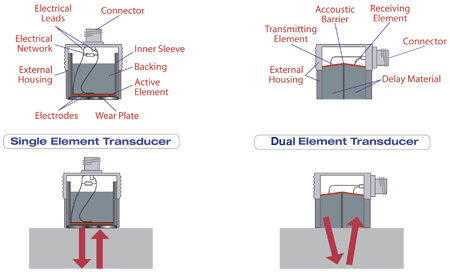探头结构
Ultrasonic transducers for thickness gauging come in a wide variety of sizes, frequencies, and case styles, but most have a common internal structure. Typically, the active element of the transducer is a thin disk, square, or rectangle of piezoelectric ceramic that converts electrical energy into mechanical energy (ultrasonic vibrations), and vice versa. When it is excited by an electrical pulse, it generates sound waves, and when it is vibrated by returning echoes, it generates a voltage. The active element, which is often referred to informally as the crystal, is protected from damage by a wearplate or acoustic lens and backed by a block of damping material that quiets the transducer after the sound pulse has been generated. This ultrasonic subassembly is mounted in a case with appropriate electrical connections. All common contact, delay line, and immersion transducers utilize this basic design. Dual element transducers, commonly used in corrosion survey applications, differ in that they have separate transmitting and receiving elements separated by a sound barrier, no backing, and an integral delay line to steer and couple the sound energy, rather than a wearplate or lens.
